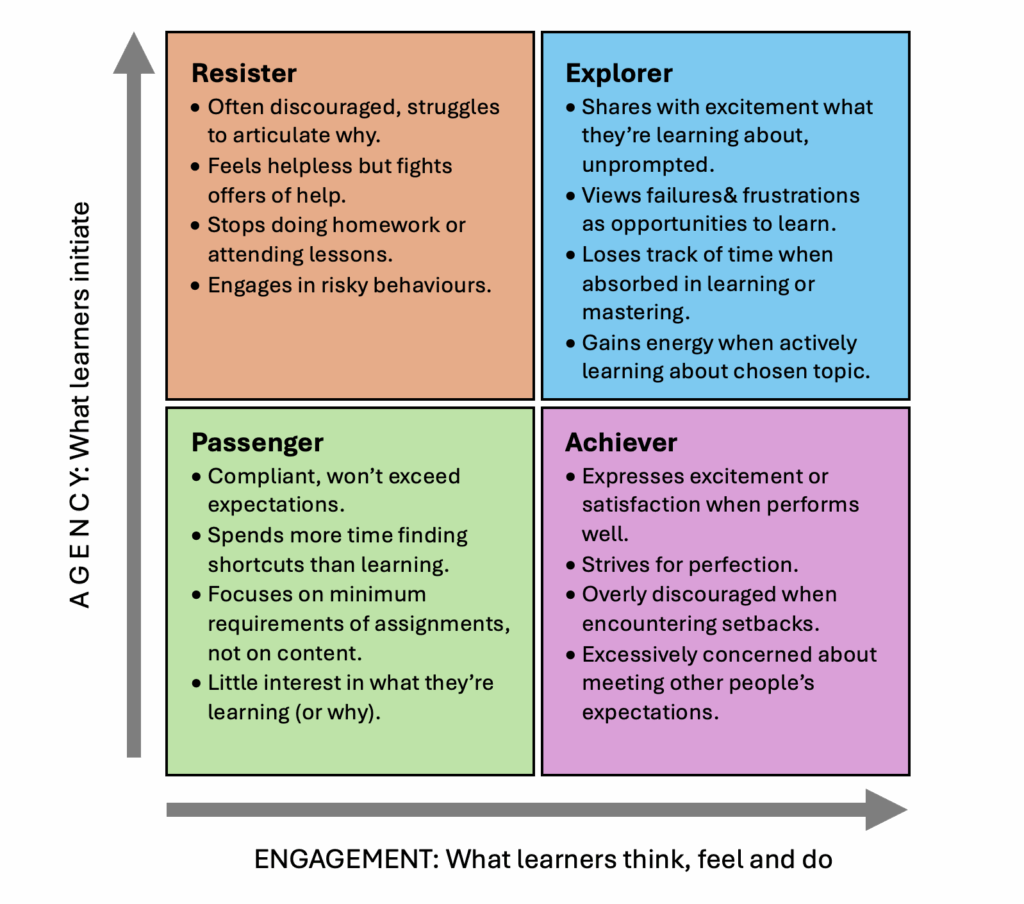Artificial intelligence may be dominating conversations in education, as we try to anticipate how our world will change and adapt our teaching practices accordingly. Yet The Disengaged Teen: Helping Kids Learn Better, Feel Better, and Live Better by Jenny Anderson and Rebecca Winthrop reminds us to pause and reflect on something more fundamental: student engagement.
This book invites us to think critically about engagement as the foundation for healthy adolescent social, emotional, and cognitive development. It transcends the AI debate because it addresses what comes first — agency in learning. Teens who take an active role in shaping their learning experience gain a stronger sense of purpose, mental well-being, and future readiness.
What Do We Mean by “Engagement”?
In an interview on WISE On Air, Rebecca Winthrop defines engagement as a multidimensional concept encompassing four interconnected dimensions:
- Behavioural engagement – evident through actions such as attentive posture, active listening, responding to questions, and following instructions.
- Emotional engagement – shown through visible feelings of curiosity, delight, empathy, or indignation, depending on the context.
- Cognitive engagement – observed when learners solve problems, apply learning to new contexts, and make predictions — in other words, when they’re operating higher up Bloom’s taxonomy.
- Agentic engagement – the most powerful and least common form, when students shape their own learning: posing questions, suggesting changes, or showing metacognitive awareness of how they learn best.
As educators, we often emphasize the first two — behavioural and cognitive — because they’re easier to observe and assess. But The Disengaged Teen challenges us to go further. Without emotional and agentic engagement, students may become compliant but passive learners who lack intrinsic motivation, curiosity, and long-term retention. In short, they may perform, but not transform.
Understanding the Four Modes of Adolescent Engagement
Anderson and Winthrop identify four “modes of engagement” that adolescents can move through in different contexts — in school, outside school, or even between subjects. At Le Rosey, where our students live and learn together, these modes appear vividly — in lessons, on the sports field, on stage, or in the boarding houses. Each mode reveals something about how students balance motivation, agency, and well-being. The image below presents a two-axis model of adolescent engagement from The Disengaged Teen, showing how agency (vertical axis) and engagement (horizontal axis) combine to create four learner “modes”: Passenger, Resister, Achiever and Explorer.

The framework illustrates that true engagement involves both interest and agency. While Achievers appear successful, only Explorers combine motivation, curiosity, and self-direction — making them the healthiest and most resilient learners. Crucially, Anderson and Winthrop warn that while Achievers often appear most successful, they are also at greatest risk of stress and mental health issues.
From the summarised descriptions in the image above, I hope you agree with me that the most beneficial outcome for our students would be to develop their Explorer mode. It might be necessary for our students at different times to switch on Resister mode (to signal when something is not working for them), Passenger mode (to create mental space to tackle a bigger/more important project), or Achiever mode (to “surpass the expectations” of a teacher they want to impress), but Explorer mode is what will allow our adolescent students to shape their future and our world with creativity, analytical problem-solving skills, adaptability, curiosity and self-awareness. As educators, we can train on how to create a learning environment that promotes the development of Explorer mode.
Looking Ahead
In my next post, I’ll share some of the Toolkit strategies from The Disengaged Teen for nurturing Explorer mode in the classroom. In the meantime, delve into the resources below and reflect on these questions:
- Would you introduce the four modes of engagement to your students? Why or why not?
- Can you identify which modes individual students tend to operate in? What evidence supports your observations?
- How might you involve students in reflecting on their own learning goals — shifting the focus away from numerical scores or grades toward authentic growth?
Resources:
- Interview. “Coaching kids to be better learners: An interview with Rebecca Winthrop and Jenny Anderson“. Brookings Institute. 6 January, 2025.
- Short article. Anderson, Jenny, and Rebecca Winthrop. “The Three Ways All Teachers Can Improve Student Engagement“. Education International. 23 January, 2025.
- Video interview. “Is Boredom, not Tech, the Real Enemy of Teen Learning? “. WISE On Air. 15 January, 2025.
- Book. Anderson, Jenny and Rebecca Winthrop. The Disengaged Teen: Helping Kids Learn Better, Feel Better, and Live Better. Penguin Random House, UK. 2025.